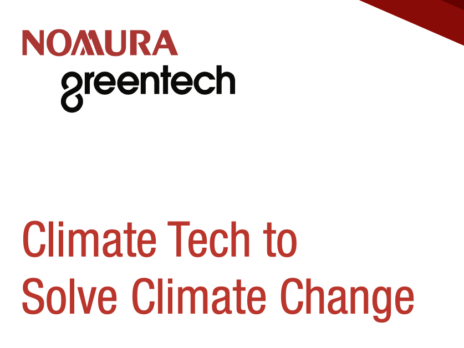
It is undeniable that human activity has warmed the planet – what scientists refer to as “anthropogenic climate change”. The journey taken since the start of the industrial revolution has led to a 50% rise in the levels of carbon dioxide (CO2) in the atmosphere from, 278 parts per million (ppm) 270 years ago to 417ppm today.

The last time CO2 levels were this elevated, 55 million years ago, the oceans were 75m higher. Since 1750, the average temperature has increased by 1.1°C. The aim of the Paris Accord is to keep warming below 2°C, ideally 1.5°C.
To achieve this objective, we need to treat emissions as a limited resource. In order to limit global warming to 1.5°C, cumulative carbon dioxide emissions must not exceed a total carbon budget of an estimated 300–500 gigatonnes (Gt) of CO2 equivalent. At current levels of greenhouse gas emissions, the planet would use this entire budget in less than ten years.
As the world we live in operates as a market economy, this resource needs a price. The establishment of a true market for emissions – with supply and demand management driving the optimal price – must be an integral part of any net-zero decarbonisation strategy.
Knowing that the planet has a natural capacity to absorb only around 10% of our current emissions levels, supply and demand factors must create a higher price. Ultimately, if the cost of carbon is sufficiently punitive, the vast majority of emissions will be replaced with new technologies, as behaviours and commercial decisions adapt.
Carbon markets should operate as a clearing mechanism for companies with residual, unavoidable emissions.
Pricing of carbon can create motives for buyers and sellers. The buyer is typically managing the cost as an externality to emitting; the seller is looking for financial reward for the capability to absorb carbon. “Deforestation – a major driver of climate change – is driven by financial incentives,” Conservation International observed by way of example in November 2021. “If you cut down a tree, you can sell the wood to buy things and plant, say, lucrative crops in its place. What offsets do is to change the math by creating financial incentives for protecting forests.”
The current state of play for carbon markets
Today, we have carbon markets in place, covering around 20% of emissions globally, with the greatest focus in Europe, but also the prospect of the market in China.
The space is formed of regulated state-run markets; “compliance markets”, normally operating as cap and trade mechanisms for top emitting sectors; and “voluntary markets”, where firms are able to buy “offsets” of carbon credit from schemes that either avoid or absorb carbon.
Initiatives we see today include the development of the new Chinese emissions trading scheme, extensions to more sectors of the EU scheme, as well as a new Carbon Border Adjustment Mechanism, and growth in voluntary and national markets, such as planned trading under the GX League in Japan.
Currently, carbon emissions are priced well below the incentive levels necessary to drive change. The average price in voluntary markets is typically less than $10 per tonne, but the World Bank has indicated a carbon price of US$100 per tonne of CO2 emitted, in line with the cost of climate change to society.
Voluntary markets will play an increasingly important role in trying to capture the 80% of emissions that are not covered by compliance markets. The voluntary carbon market has grown rapidly in recent years to reach about $2bn but has the potential to be 50 times as big given the scale of generated emissions.
Article 6: the last puzzle piece
The Cop26 summit in Glasgow completed the rule-making that followed the Paris Accord. The last piece of the puzzle was Article 6, mechanisms for the trading of carbon offsets.
The purpose was to establish a Cop-approved protocol for trading carbon credits, avoiding double counting of offsets, and achieving an overall reduction in emissions.
While Cop is focused on national outcomes, there is also the complexity of national and corporate interests in how offsets are used.
Carbon credits were first addressed under the Kyoto Protocol (1997), which only required rich nations to track emissions. This enabled key countries such as Brazil to sell offsets with no impact on their own position.
The Paris Accord, however, created global emissions commitments, and the implication that credits sold should be removed from the host’s achievements to avoid double counting of offsets. This further extends to businesses – ultimately, the principal is in place that credits sold require “corresponding adjustments”.
This was a key negotiation issue for rainforest nations – Brazil, for example, uses renewables for 45% of its energy, but is a big emitter globally through deforestation and farming impacts.
Offsetting nerves and social pressures
We should be clear that carbon pricing mechanisms ultimately act as taxes. And taxes can be regressive on society, so care is needed in the design. Protests at rising fuel prices have erupted in several countries, most notably in France, with the ‘Gilet Jaunes’ movement.
This can be addressed through social adjustments: noting that the purpose of a carbon tax is to change behaviours, not to raise tax revenue, coupled with social welfare adjustments – revenues returned through another route – can have the desired effect.
While economic theory tells us that supply and demand will create the right price and residual levels of emissions, we are far from that position today. We have partial market structures in place, a lack of interconnectivity and issues with credibility.
These factors can lead to suboptimal outcomes, including the purchase of poor quality, under-priced carbon credits to try to improve a firm’s image. In the worst-case scenario, this could lead to strategies that run counter to the aim of reducing emissions. The faster the world moves towards meaningfully integrated carbon markets, the better our chances of achieving net zero.







